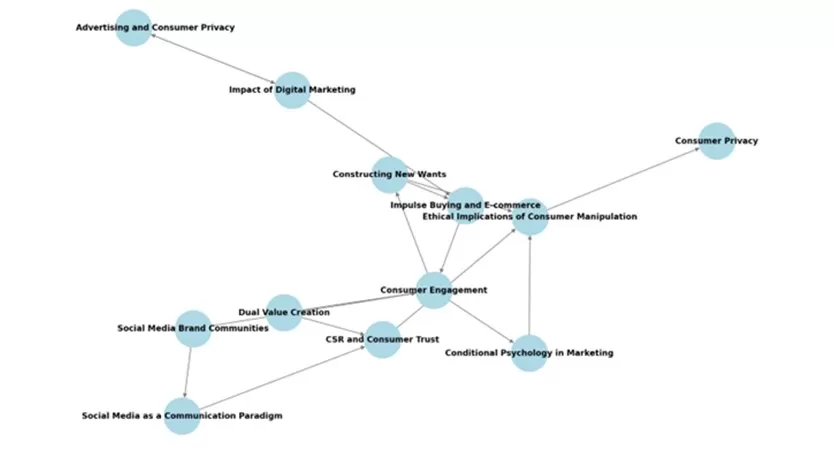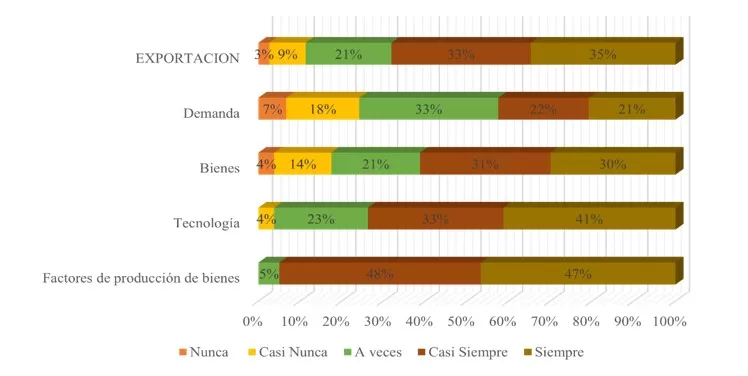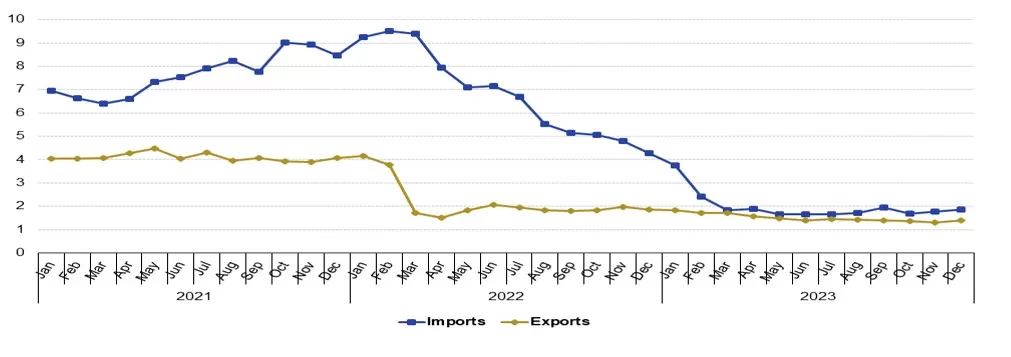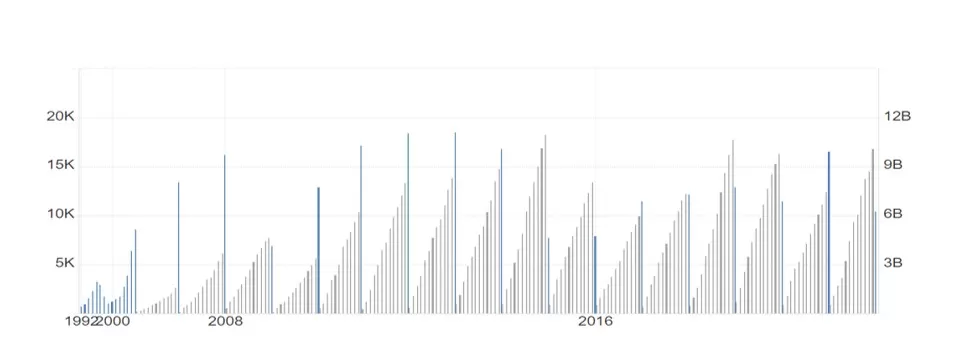Introduction
Today, marketing is critical for economies as it impacts consumer buyer behaviors and consumption conditions. The evolution of marketing from barely responding to and actively constructing new wants presents an opportunity and a challenge (Nadella et al., 2023). This dual marketing function introduces concern about its impact on consumers and society. Whether marketing fulfills pre-existing needs or forms new desires has been argued (Al-Shammari et al., 2022).
Digital marketing and data analytics development have equipped marketers to understand and control consumer behavior at an unusual scale (Gabelaia, 2019). Besides, it increases concerns about creating artificial or induced wants. This dual marketing function is imbalanced, where businesses may strategically create and promote needs aligned more with profitability than consumer welfare (Nadella et al., 2023).
The authors aimed to explore the dual role of marketing in shaping consumer desires through a conditional psychology framework. The main objective was to evaluate the impact of marketing strategies on consumer perception and behaviors. The authors asked two research questions: How do consumers perceive marketing’s role in influencing their desires and needs? Moreover, to what extent do marketers strategically use conditional psychology principles to drive these perceptions?
This study used a mixed-method approach. The authors used snowball and conventional sampling. One hundred thirty-one respondents offered their perceptions regarding the impact of marketing on their desires and needs. Furthermore, eleven marketing executives were interviewed.
The conditional psychology framework studies how consumers respond to conditional stimuli—external cues such as persuasive advertising, emotional appeals, and personalized messaging—that influence cognitive and emotional responses. In marketing, conditional psychology explores how strategic stimuli can trigger desires and preferences, leading to the building of new wants (Over & Cruz, 2019; Pfeifer, 2013). The framework delivers a lens through which the dual role of marketing can be critically analyzed, emphasizing how psychological conditioning can result in perceived needs that align with developing consumption patterns and market trends.
The findings of this study reveal a significant correlation between targeted marketing efforts and the emergence of new consumer needs. Survey results indicate that most respondents acknowledge that marketing campaigns actively construct new wants, often using emotional appeals and persuasive techniques. Furthermore, the interviews further validated these perceptions. Marketing executives recognized the strategic use of conditional stimulus in campaigns to stimulate emotional connections and drive desire for products and services. Moreover, marketing executives addressed the challenges of managing the fine line between consumer empowerment and market-driven manipulation.
Finally, these findings have significant implications for both marketers and consumers. This study contributes to the understanding of marketing’s dual role. Exploring the intersection of marketing strategies and psychological conditioning proposes valuable insights into marketers’ ethical and strategic challenges in an increasingly consumer-driven culture.
Literature Review
The Dual Role of Marketing
Today, businesses increasingly depend on social media communities to interact with consumers (Al-Shammari et al.,2022). Thus, it is essential to understand how businesses can extract value from consumers in social media brand communities (Wang et al., 2021). Consumer value is a dual concept (Lo et al., 2022). To be successful, businesses need to create value and extract for consumers (Kotler & Keller, 2016). Consumers identify and distinguish consumer-perceived value and consumer-generated value in social media (Wang et al., 2021). The dual function of marketing has long been a focal point in marketing research (Al-Shammari et al., 2022). This dual role is essential for marketers’ strategic intent and the ethical considerations of constructing new wants (Nadella et al., 2023). Through a conditional psychology lens, marketing’s impact on consumer behavior extends beyond immediate needs to encompass emotional and cognitive conditioning (Zhang & Zhang, 2024; Al-Shammari et al.,2022; Lei et al.,2020).
Customer engagement is a significant concept in marketing that refers to customers’ behavior towards a firm originating from the motivational driver (Barari et al., 2021; Lei et al., 2020; Kotler & Keller, 2016; Solomon, 2019). Kotler and Keller (2016) highlight that marketing seeks to identify and satisfy consumer needs and aims to inspire desires by introducing novel products and services.
Nowadays, technologies like AI are advancing and transforming quickly, and others are evolving more difficultly in shared spaces. Consumer trust heavily impacts its capabilities (Nadella et al., 2023; Lei et al., 2020). Companies have developed and executed distinct types of CSR to develop social value and enhance consumer relationships (Yoo, 2023). Social media have constructed new business communication channels (Wang et al., 2021; Papadopoulou et al., 2022).
The vision of impulsive buying (IB) has been researched broadly over the past decades across both academic and practical fields (Wang et al., 2021). The proliferation of e-payment, e-commerce, and social (s-) commerce in recent years has shifted the examination of impulsive buying behavior from brick-and-mortar to online retail settings (Lo., 2022; Yoo, 2023; Zaltman, 2003)
This duality is magnified in studies examining how firms leverage psychological and emotional appeals to construct consumer wants (Belk, 2013; Zaltman, 2003; Lei et al., 2020; Papadopoulou et al., 2022). Belk (2013) argues that consumer desires are not fixed but are dynamically constructed through marketing narratives, which implant aspirational identities within products. Zaltman (2003) concurs that marketers tap into subconscious motivations to stimulate emotions that redefine consumer wants (Yoo, D. 2023). As an alternative to traditional advertisements, targeted advertising is more efficient in brand building and customer acquisition while reducing costs (Delgosha & Hajiheydari, 2021; Yoo, 2023). The targeted advertising of mobile users is accomplished by online behavioral targeting, which is a process that precisely delivers customized information to mobile users (Wang., 2022; Papadopoulou., 2022; Barari., 2021).
Conditional Psychology and Consumer Behavior
Conditional psychology examines how external stimuli trigger learned responses (Over & Cruz, 2019; Pfeifer, 2013; Operario et al., 2013). This provides a framework for understanding how marketing shapes consumer desires (Pavlov, 1927; Skinner, 1953; Byrne et al., 2019). Pavlov’s (1927) and Skinner’s (1953) work on operant conditioning extends this idea by suggesting that reinforced behaviors can lead to long-term changes in consumer preferences.
In marketing contexts (Rescorla, 2014), conditional stimuli are strategically employed to evoke specific responses that align with brand messages (Aaker, 1991; Keller, 2009; Byrne et al., 2019; Pfeifer, 2013). Aaker (1991) reveals how brand personalities are developed. Operario et al. (2013) highlight how conditioning consumers see products as extensions of their identities. Moreover, the literature on emotional conditioning highlights the role of emotions in shaping consumer desires (Byrne et al., 2019; Bagozzi et al., 2002; Hirschman & Holbrook, 1982; Bagozzi et al., 2002) and explains how emotional appeals in advertising can create lasting associations (Martin & Levey, 2013), turning products into symbols of happiness, success, or self-worth (Hirschman & Holbrook, 1982; Rescorla, 2014), and providing empirical evidence that emotional narratives lead to stronger loyalty and perceived value.
Cognitive conditioning focuses on marketing messages that lead to new wants (Cialdini, 2009; Kapferer & Bastien, 2009). Cialdini (2009) presents how conditional cues create cognitive biases that shape consumer desires. Similarly, Kapferer and Bastien (2009) and Pfeifer (2013) explore how cognitive biases influence consumer choices (Worthing, 2021), constructing new preferences and wants.
Marketing and the Creation of Modern Wants
Changing brand attitudes impact conditioning (Sweldens et al., 2010; Cohen et al., 2018). Scholars acknowledge the role of marketing in constructing new wants that align with evolving social stimuli (Bauman, 2008; Nigam & Dewani, 2021). Bauman (2008) examines how marketing contributes to a “liquid” consumer culture, where desires are constantly redefined in reaction to current trends. Lantos, G. P. (2015) reinforces this notion, arguing that marketing processes are a cultural intermediary, shaping perceptions of value and need. Theories of consumer behavior often assert that consumers are rational agents making intended decisions about the branded products and services they purchase and use (Mullen & Johnson, 2013). It is assumed that an explicit formation of attitudes foregoes consumer decisions and needs that determine the brand of choice (Martin & Morich, 2011).
Everyday life has many opportunities to associate consumer products with success or failure (Hamerman & Johar, 2013). This role of marketing as a creator of modern wants is evident in the luxury and technology sectors, where aspirational desires are constructed through status and innovation (Lantos, 2015; Kapferer & Bastien, 2012; Nigam & Dewani, 2021). Lantos (2015) first recognized this sensation in his theory of conspicuous consumption, which indicates that consumers derive pleasure from visible displays of wealth. Kapferer and Bastien (2012) build on this by showing how luxury brands strategically create new wants through exclusivity and craftsmanship narratives.
Applying conditional psychology in marketing addresses consumer autonomy and manipulation (Lantos, 2015; Crisp, 1987). Lantos (2015) highlights ethical breaches when marketers exploit conditional stimuli to create artificial desires. Crisp (1987) claims that such strategies can undermine consumer autonomy (Mullen & Johnson,2013), making choices more reflective of marketing intent than genuine consumer interest. Moreover, scholars warn against using emotional and cognitive conditioning techniques, contributing to overconsumption (Holt, 2002; Richins, 1994; Cohen et al., 2018).
The Role of Digital Marketing in Shaping Desires and Needs
Digital marketing has strengthened the influence of conditional stimulus on consumer behavior (Lamberton & Stephen, 2016; Vinerean et al., 2013). Lamberton and Stephen (2016) explain how digital platforms provide marketers with unparalleled access to consumer data, enabling them to tailor conditional stimuli to individual preferences (Zhu & Chen, 2015). Besides, digital marketing’s role in shaping desires involves using immersive experiences (Stephen, 2016; Ashley & Tuten, 2015; Voorveld et al., 2018). Ryan, D. (2016) explores how immersive content creates emotional engagement and reinforces conditioned associations. Voorveld et al. (2018) offer empirical evidence of how interactive advertisements increase consumer involvement, forming new wants.
Digital marketing is significant in shaping consumers (Stephen, 2016). It ultimately influences purchasing decisions and builds stronger brand relationships with customers through targeted and interactive campaigns (Ashley & Tuten, 2015; Vinerean et al., M. (2013). This allows businesses to engage with consumers at the right time and place (Gabelaia & McElroy, 2023; Vinerean et al., 2013).
The literature on marketing’s dual role reveals a complex interplay between strategic and psychological conditioning (Stephen, 2016; Ryan, 2016). Through a conditional psychology lens, marketing does not respond to consumer needs but actively constructs new desires through emotional and cognitive stimuli (Godey et al., 2016). This introduces ethical considerations regarding the autonomy and welfare of consumers (Stephen, 2016). As digital marketing continues to grow, conditional psychology in marketing requires further research (Ryan, 2016).
The possibility of consumer interaction with brands has engendered significant debate within the marketing-focused discourse on the fundamental challenges and transformative opportunities for marketers (Ashley & Tuten, 2015; Dwivedi et al., 2023). Social media are highly embedded in our lives, reaching 82% of the world’s Internet population aged 15+. They represent most individuals’ Internet usage, accounting for 1 of every 5 minutes spent globally. They have become the new communications paradigm for company-to-consumer message delivery (Godey et al., 2016). As a result, U.S. companies spent $5.1 billion on advertising on social media in 2013, wishing to promote their products (Zhu & Chen, 2015). People are revealing themselves to increasingly more digital and social media (Vinerean et al., 2013). This is for many purposes, including, in their functions as consumers, searching for information about products, purchasing and consuming them, and communicating with others about their experiences (Ashley & Tuten, (2015). Marketers have responded to this fundamental shift by increasing their use of digital marketing channels (Stephen, 2016; Zhu & Chen, 2015).
Research Methodology
The authors used a mixed-methods approach to explore marketing’s dual function in shaping consumer desires and constructing modern desires. This method delivers just-in-time and evidence-based data. To explore this phenomenon, a survey study with in-depth interviews was used. The survey delivered broad insights into consumer perceptions of marketing’s role in shaping desires and needs. In contrast, in-depth interviews aimed to explore marketing executives’ strategic intent and thought processes, highlighting the application of conditional psychology principles in shaping consumer behavior. This study was grounded in a conditional psychology framework. This framework explores how marketing stimuli initiate emotional and cognitive responses that redefine consumer preferences and wants.
In this study, 131 respondents participated in the voluntary survey, which was satisfactory for achieving statistical reliability. Participants were selected to reflect diverse demographics such as age, gender, ethnicity, lifestyle, education, income, and household type. Furthermore, eleven marketing executives from diverse industries were interviewed. Respondents were selected through purposive sampling. These executives represented diverse industries such as technology, FMCG, and healthcare and had at least five years of strategic marketing experience. Gender distribution was balanced, with 55% male and 45% female. Educationally, all executives hold at least a bachelor’s degree, with 70% holding advanced degrees.
Data were collected using QuestionPro Software. The questionnaire consisted of three main sections: demographics. Second consumer perception of marketing. This section used a Likert scale, 1 – strongly disagree to 5 – strongly agree, to measure participants’ beliefs about the influence of marketing on their desires and needs. Third was the impact of Marketing Stimuli. Respondents were asked to rank the impact of different marketing stimuli, such as personalized content, visual and auditory elements in advertisements, influencer endorsements, and emotional narratives, on their purchasing behavior and desires.
Furthermore, semi-structured interviews were conducted via Zoom and transcribed using Zoom and Otter. The interview guide was divided into three sections. First, Marketing executives were questioned about the strategic objectives behind their marketing campaigns, concentrating on how they sought to shape consumer perceptions and influence purchasing decisions. Second, executives were asked about the application of conditional psychology. This section explored how principles of conditional psychology, such as emotional appeals, brand associations, and personalized messaging, were incorporated into marketing strategies. Executives shared detailed examples of campaigns that applied these principles to condition consumer responses. Third, executives were asked about the ethical implications of their strategies and the balance between shaping desires and serving genuine consumer needs.
Research Findings
Literature Findings
The authors conducted a systematic literature review. Fifty-one articles were included in this research based on identification, screening, and eligibility criteria. Accordingly, the authors found the following themes presented in Figure 1. This is a simple mind map visualizing the connections between critical themes in marketing and consumer behavior. Dual value creation in marketing generates value for the consumer and the company. This concept acknowledges that successful marketing strategies fulfill consumer needs and contribute to the company’s objectives. By focusing on dual value creation, companies can build sustainable and mutually beneficial relationships where consumers feel genuinely valued, and companies reach competitive advantage and longevity.

Fig 1. Themes of Literature Review (Developed by the Authors)
Survey Findings
The author conducted a survey between March 2nd – June 15th, 2024. The authors explored the dual role of marketing in shaping consumer desires through a conditional psychology framework. The demographic diversity of the survey participants allowed a robust analysis of consumer behavior and marketing perspectives across different segments. The main age group was 25–34, showing the active workforce as a primary target demographic for most marketing strategies. Gender balance showed inclusivity. Ethnic diversity delivered insights into multicultural consumer behavior, which is critical for marketers operating in diverse markets. The education and income distribution offered a nuanced understanding of how socioeconomic factors influence consumer decisions.
The research findings identified significant factors correlating with purchasing behavior, specifically impulsive buying, product research, and reliance on reviews. The first correlation was brand loyalty and openness to the latest brands. A moderate positive correlation with impulsive purchases (.150) suggested that consumers open to the latest brands may buy impulsively and rely on reviews (.117). Second was product expectations (convenience and speed). It positively correlated with impulsive purchases (.137) and reliance on reviews (.122), suggesting that convenience and service speed drive spontaneous buys and review dependence.
Third was technological comfort. It strongly correlated with product research (.311) and impulsive purchases (.120), suggesting that tech-savvy consumers frequently research products online and make spontaneous purchases due to digital accessibility. Next was social media usage. Related to impulsive purchases (.126) and product research (.106), social media orientation suggests spontaneous buying and serves as a discovery mechanism for informed purchasing. Last but not least was marketing influence and trend following. This correlated with review reliance (.130), suggesting trend-followers seek external validation before purchasing. Last was environmental awareness. It correlated with impulsive purchases (.093), suggesting that eco-friendly options can prompt quick buying decisions.
Furthermore, the authors intended to explore perceptions and behaviors among boomers, millennials, and Gen Z in their answers to marketing influence, brand loyalty, channel preferences, product expectations, environmental awareness, technology adoption, social values, and purchasing behavior. Moreover, marketing influence revealed varied reactions across generations. Boomers showed moderate influence from marketing campaigns, while Gen Z tended to be more skeptical, especially regarding how marketing affects their purchasing decisions. On the other hand, millennials placed the highest importance on authenticity, recalling a preference for authentic marketing narratives over promotional content.
Nevertheless, brand loyalty was highest among boomers, who favored trusting brands aligned with their established consumption patterns. In contrast, Gen Z and Gen Alpha were receptive to examining the latest brands that align with their values or proposed innovative solutions. This trend indicated that loyalty in younger generations may rely more on brand values and novelty. Furthermore, preferred channels demonstrated generational preferences toward different media for product discovery. Millennials preferred digital channels like social media, while boomers trusted more traditional media. Gen Z also favored digital channels but approached influencer marketing cautiously, indicating a more selective use of social media content for purchasing decisions. Next, regarding product expectations, Gen Alpha and Gen Z recognized a higher value for personalized experiences and quality assurance, reflecting their demand for tailored services. Boomers prioritized standard, designated product attributes over personalization and aligned with a more traditional consumption mindset.
Moreover, environmental awareness was significantly higher among Gen Z, who strongly emphasized sustainability in their purchasing decisions. Boomers scored lower on these measures, indicating that eco-consciousness was less of a priority. This growing environmental emphasis among younger consumers recalled a shift toward eco-consciousness in the marketplace. Besides, technology adoption revealed boomers’ comfort with in-store shopping, though they also revealed adaptability to digital purchasing. Gen Z and millennials exhibited balanced comfort with digital shopping channels and technology-driven shopping enhancements, such as online shopping via apps, demonstrating a shift towards convenience and accessibility through technology. Furthermore, social values were reflected differently across generations.
Boomers highlighted stability and inclusivity in their preferred brands. Gen Z highly valued diversity and inclusiveness and critically evaluated brands. At the same time, millennials revealed a slight decline in focus on social justice compared to Gen Z, reflecting a generational shift in social priorities. Lastly, purchasing behavior varies. Millennials were the most impulsive in their buying habits, making them more susceptible to immediate purchase decisions influenced by marketing content. In contrast, Gen Z strongly preferred researching products and reading reviews before purchasing, indicating a more information-driven and cautious approach.
These insights emphasized the diversity in consumer behavior across age groups. Boomers favored brand loyalty and traditional channels, millennials demonstrated a tendency for digital and impulsive behaviors, and Gen Z highlighted eco-conscious, critical, and research-oriented purchasing. These patterns demonstrated the need for targeted marketing strategies aligning with each generation’s values and behaviors.
To continue, the authors interpreted these demographic differences through the lens of conditional psychology, which demonstrated distinct generational patterns shaped by unique conditioning factors. In conditional psychology, specific conditions or psychological triggers impact behaviors and preferences. The findings are illustrated in Figure 2.
Figure 2 illustrates that boomers’ responsiveness to marketing may be embedded in vulnerability to traditional marketing strategies that echo their values and familiarity. This conditioned response indicated that established advertising practices hold persuasive power for boomers due to a lifetime of exposure to consistent brand messaging. Conversely, younger generations like Gen Z and Gen Alpha revealed a conditioned doubt toward marketing, influenced by digital overexposure and a liking for authenticity over conventional advertising, creating a barrier to traditional marketing influence.
Moreover, the findings illustrate that boomers’ and Gen Z’s high brand loyalty echoes psychological conditioning around trust and reliability created from various sources. Long-standing relationships with established brands shape boomers’ loyalty. For Gen Z, loyalty was frequently contingent on shared values, authenticity, or innovative brand promises, demonstrating a conditional loyalty based on alignment with their ideals. This difference emphasizes that while both groups value loyalty, the conditioning factors—traditional trust for boomers versus values alignment for Gen Z—differ significantly. These were essential findings.
Furthermore, millennials’ strong engagement with digital channels showed a conditioning toward convenience, immediacy, and connectivity suggested by digital platforms, especially social media. For boomers, engagement with digital channels was driven by gradual adaptation to digital solutions for comfort and access. This indicated conditional preferences based on generational exposure, with millennials conditioned to favor online interactions while boomers balance digital and traditional channels. Moreover, Gen Alpha and Gen Z’s focus on product quality over brand names echoed conditioning toward intrinsic value and tangible benefits, frequently shaped by a consumer culture concentrated on quality over reputation. This conditioning may arise from a digital landscape where product reviews and quality benchmarks are more accessible and transparent, leading younger generations to prioritize product substance over brand prestige.
Gen Z’s prioritization of environmental factors emphasized their conditioning toward eco-consciousness, which is affected by global narratives around climate change, environmental responsibility, and social media advocacy. Millennials also exhibit eco-conscious trends, conditioned by similar cultural shifts. Environmental awareness was a conditionally triggered value for these generations, activated by a societal focus on sustainability and ethical consumption. Further, boomers’ convenience with technology was a product of conditioned adaptation from practical engagement with technology in professional or daily life settings. For millennials and Gen Z, proportional tech-savviness was an intrinsic condition, as these generations grew up with technology as an integral part of life, enabling natural ease with digital devices and innovations.
The alignment with social values in boomers and Gen Z indicated a shared psychological trigger around value-driven branding, though conditioned by different societal forces. Boomers may prioritize stability and inclusivity due to traditional societal norms. At the same time, Gen Z’s alignment was more critical and issue-focused, shaped by digital exposure to social justice and inclusive narratives. This conditional focus on values highlighted the importance of brands authentically aligning with generational values for effective engagement.
In summary, figure 2 shows that each demographic’s preferences and behaviors are conditioned by unique societal, technological, and cultural factors that shape their consumer psychology. These conditioned reactions underscore the impact of age-specific vulnerabilities and experiences, with each generation reacting to marketing, brand loyalty, and social values based on distinct psychological triggers. Tailor-made marketing is necessary for meaningful engagement.

Fig 2. Comparison by Demographics rooted in Conditional Psychology (Developed by the authors)
The authors explored digital generational preferences within the framework of conditional psychology. This demonstrated how unique psychological conditioning impacts each generation’s engagement with digital channels and technology, consequently challenging the dual function of marketing. Figure 3 highlights digital generational preferences with conditional psychology.
Millennials’ strong dependence on social media for product finding echoed a conditioned response to convenience and immediate access. Their high engagement indicated that social media are a primary source of product information, conditioned by social validation and connectivity in a digital-first environment. Gen Z indicated a slightly more selective engagement due to an aggravated awareness of digital authenticity, impacted by their upbringing in a highly curated, content-rich digital landscape. Moreover, Boomers’ and Millennials’ responsiveness to influencers suggested a conditional trust rooted in authority and credibility. For Boomers, the power of trusted figures aligns with traditional marketing’s reliance on authoritative endorsements, a conditioned response from years of exposure to celebrity and expert endorsements. Millennials’ trust in influencers echoed a conditional choice for relatability and aspirational figures in digital culture, where influencers are seen as accessible yet credible sources of advice. In contrast, Gen Z and Gen Alpha revealed lower responsiveness, conditioned to evaluate influencer content critically.
Boomers’ surprising convenience with tech-enabled shopping echoed conditioned adaptability to digital tools driven by necessity, such as increased online transactions in recent years. Millennials and Gen Z, by contrast, revealed intrinsically high comfort with technology, conditioned from an early age by digital integration into everyday life. This convenience means rooted ease with tech-driven shopping, where digital convenience is perceived as a norm rather than an adaptation.
This study from Figure 3 shows how generational conditioning changes digital behaviors. Traditional conditioning around authority influences and adaptation to digital instruments was apparent for Boomers. Millennials and Gen Z exhibit conditioning from an immersive digital culture, driving them toward convenience, authenticity, and social proof in product discovery. These insights emphasize the significance of understanding conditional psychological factors when engaging each generation through digital platforms.

Fig 3. Digital generational preferences with conditional psychology (Developed by the Authors)
Interview Findings
The authors interviewed eleven marketing executives about marketing’s dual role in shaping consumer desires and constructing modern wants. The interviews aimed to grasp how executives perceive marketing roles, their strategic intentions, and how they manage ethical considerations. The initial request was sent to thirty-one marketing executives between March and June 2024. Eleven voluntarily accepted the invitation to participate. Selected marketing executives received interview questions, and Zoom interviews were performed. Ten strategically designed questions were asked, and interviews lasted between 26-32 minutes. Some significant questions asked were: How do you perceive the dual role of marketing in shaping desires and constructing new wants? What strategic decisions do you make to manipulate consumer desires? How do you use emotional and cognitive appeals in marketing campaigns? Do you believe marketing primarily fulfills existing needs or constructs new desires? What ethical considerations guide your marketing strategies? How do you balance creating new wants with ensuring consumer welfare? How do you measure the success of campaigns to shape desires? How do you assess consumer feedback regarding the influence of your campaigns? What role does digital media play in constructing new wants? Do you think the impact of marketing on desires differs across generations?
The authors grouped marketing executives’ responses into three groups. Table 2 shows the breakdown and highlights key findings, especially regarding emotional appeals. The findings demonstrated that all executives agreed on the importance of emotional triggers, particularly in building brand connections. However, Group A highlighted appeal authenticity, while Group C preferred aspirational narratives to stimulate new desires. Furthermore, Group B executives relied on rational appeals, underlining product features and benefits to satisfy consumer needs rather than creating new desires.
Table 2. Interview breakdown based on themes observed (Developed by the Authors)

Group C was the most aggressive in creating new wants, while Group B favored staying within the boundary of fulfilling existing needs. Group A executives embraced a middle-ground approach, creating desires while assuring they aligned with growing consumer trends. Moreover, all executives recognized the ethical implications of creating wants. Group A concentrated on transparency and consumer welfare, while Group C acknowledged empowering consumers to make informed choices. Group B highlighted the boundaries of not violating boundaries.
The authors identified the following patterns. First is the initiative-taking creation of wants, with the majority (6 executives) relying on strategically creating new wants, using a mix of emotional and cognitive appeals to align with growing lifestyles. An emphasis on authenticity was the second element. Most executives (8 out of 11) highlighted the significance of authenticity in shaping desires, emphasizing transparency as a necessary driver of consumer trust. Lastly, generational variations, all executives compromised that generational differences play a role, with younger generations (Gen Z) indicating more resistance to overt marketing efforts and valuing authenticity. At the same time, Millennials are more receptive to personalized and influence-based appeals.
Furthermore, the bar chart, figure 4, compares executive groups’ focus on marketing strategies and ethical considerations. Group C proactively highlighted creating new wants, while Group A held a moderate approach, and Group B focused less on this strategy. Group B highlighted fulfilling existing needs over creating new desires, echoing their careful approach to impacting consumer behavior. All groups acknowledged the significance of emotional appeals, with Group C focusing slightly more on this strategy than others. Group B prioritized cognitive appeals, concentrating on rational product features and benefits, while Group A and Group C employed these appeals moderately. Group A strongly highlighted authenticity, which was necessary for gaining consumer trust. Group C also valued authenticity but offset it with trend-setting efforts. Group A concentrated on empowering consumers through transparent communication, while Group C also valued this but highlighted the latest trends. Group C used digital media to create new desires, while Group A and Group B utilized digital channels to differing extents for other purposes.
This comparison emphasizes key contrasts in strategic approaches, demonstrating how diverse groups balance fulfilling needs, creating new desires, and managing ethical considerations in their marketing efforts.

Fig 4. Comparison of Marketing Executive Groups on Strategies and Ethical Considerations (Developed by the Authors)
Furthermore, the horizontal bar, figure 6, shows the critical priorities of marketing executives across various strategies. They prioritized authenticity in their marketing strategies, highlighting transparent communication and genuine messaging to create consumer trust. Emotional connections are highly prioritized, echoing the significance of engaging consumers emotionally to impact their desires and decisions. Executives use digital media to gain consumers and develop targeted, personalized campaigns. Another critical priority is entrusting consumers with informed choices and clear messaging, providing marketing efforts aligned with consumer welfare. Managing and fulfilling consumer needs stays a central focus, offsetting proactive marketing efforts. Marketing executives recognized the significance of developing new wants but approached this with caution and strategic intent.
This highlighted the balanced approach taken by executives, with a strong emphasis on authenticity, emotional appeals, and the strategic use of digital media.

Fig 6. Executives Priorities in Marketing Strategies (Developed by the Authors)
Discussions
In this study, the authors used a conditional psychology framework to analyze how marketing creates new wants and shapes consumer desires (Barari et al., 2021; Lei et al., 2020). In classical and operant conditioning, conditional psychology explores how repeated exposure to specific stimuli can condition consumer responses, affecting their desires and behaviors (Pavlov, 1927).
The survey highlighted how conditional stimuli in marketing—such as emotional appeals, personalized messages, and social proof—conditioned consumers’ responses (Pavlov,1927; Aaker (1991). For instance, Millennials’ impulsive purchasing behavior correlated strongly with digital marketing efforts and influencer recommendations. This finding can be justified by operant conditioning, where positive reinforcement strengthens impulsive buying tendencies (Zhang & Zhang, 2024).
On the other hand, Gen Z’s focus on authenticity and dependence on peer-based reviews echoes their conditioned preference for trustworthy and transparent messaging (Pavlov, 1927; Aaker,1991). Here, classical conditioning plays a role, as repeated exposure to genuine and value-driven content has shaped Gen Z’s cognitive associations with brands that prioritize honesty over promotional tactics (Wang., 2022; Papadopoulou., 2022; Barari., 2021).
Furthermore, interviews with executives endorsed the strategic application of conditional psychology principles in marketing campaigns. Many executives have accepted using emotional conditioning to create brand resonance and foster consumer connections (Lantos, 2015; Kapferer & Bastien, 2012). For instance, executives from Group C deliberately prepared aspirational narratives that stimulate specific emotions, reinforcing desires for products associated with status, lifestyle, or success. Besides, executives also reported the strategic use of conditional cues, such as exclusivity signals, brand imagery, and repeated brand exposure, to shape consumer expectations and create new wants. By associating products with desirable attributes or aspirations, these marketers actively conditioned consumer preferences, forming new desires aligned with evolving trends (Wang et al., 2021; Papadopoulou et al., 2022).
Emotional triggers were recognized as fundamental in shaping consumer responses (Papadopoulou et al., 2022). Despite acknowledging the effectiveness of conditioning techniques, executives highlighted the ethical responsibility of using these methods transparently. They admitted the fine line between conditioning and manipulating consumer behavior, reinforcing the need for a value-driven approach.
Conclusion
The results demonstrate that the authors explored marketing’s dual role of shaping consumer desires and constructing modern wants, which are significant contributions to theory and practice, especially through conditional psychology. 131 respondents and eleven marketing executives were fundamental as they offered rich insights. The results emphasized that marketing has both a reactive and a proactive power, fulfilling consumer needs and strategic appeals.
The results demonstrated significant correlations between marketing efforts and consumer behavior. This revealed that rational and emotional appeals influence consumers. Besides, the interview results added goodness and trustworthiness to the quantitative findings. Marketing executives recognized marketing’s dual role, with some focusing on fulfilling needs while others proactively constructed new wants.
The study indicated that conditional psychology is a robust framework for understanding how marketing stimuli condition desires and shape new wants. Therefore, the authors offer practical value by providing actionable insights for marketing professionals. The focus on authenticity and strategic use of emotional appeals emphasizes the need for brands to support transparency and align their narratives with consumer values. Furthermore, the authors contribute to the theoretical value. The authors extend scholarships in the existing literature by demonstrating how conditional stimuli trigger cognitive and emotional responses, shaping new consumption patterns.
The authors recommend future research by exploring the long-term effects of constructed desires on consumer well-being and brand loyalty; second, further research on emerging digital trends such as AI and AR.
As a final recommendation, this research article emphasized the transformative power of marketing in shaping desires and constructing modern wants. It highlighted the significance of authenticity, strategic intent, and ethical considerations in influencing consumer behavior. By integrating practical insights with theoretical frameworks, the authors contribute to a broader discourse on marketing’s growing role in a consumer-driven society.
Acknowledgment
A Special Thank You to Ms. Vivian Tracy, a student research assistant who massively contributed to developing the research ideas and concept of integrating conditional psychology into marketing.
References
- Aaker, D.A. (1991) Managing Brand Equity. The Free Press, New York.
- Al-Shammari, M. A., Banerjee, S. N., & Rasheed, A. A. (2022). Corporate social responsibility and firm performance: A theory of dual responsibility. Management Decision, 60(6), 1513-1540.
- Ashley, C., & Tuten, T. (2015). Creative strategies in social media marketing: An exploratory study of branded social content and consumer engagement. Psychology & marketing, 32(1), 15-27.
- Bagozzi, R.P., Gopinath, M. and Nyer, P.U. (2002) The Role of Emotions in Marketing. Journal of the Academy of Marketing Science, 27, 184-206. http://dx.doi.org/10.1177/0092070399272005
- Barari, M., Ross, M., Thaichon, S., & Surachartkumtonkun, J. (2021). A meta‐analysis of customer engagement behaviour. International Journal of Consumer Studies, 45(4), 457-477.
- Bauman, Z., & Haugaard, M. (2008). Liquid modernity and power: A dialogue with Zygmunt Bauman. Journal of Power, 1(2), 111-130.
- Belk, R. W. (2013). Materialism and Consumer Culture. Routledge.
- Byrne, R. M., Evans, J. S. B., & Newstead, S. E. (2019). Human reasoning: The psychology of deduction. Psychology Press.
- Cialdini, R. B. (2009). Influence: Science and practice (Vol. 4, pp. 51-96). Boston: Pearson education.
- Cohen, J. B., Pham, M. T., & Andrade, E. B. (2018). The nature and role of affect in consumer behavior. In Handbook of consumer psychology (pp. 306-357). Routledge.
- Crisp, R. Persuasive advertising, autonomy, and the creation of desire. J Bus Ethics 6, 413–418 (1987). https://doi.org/10.1007/BF00382898
- Delgosha, M. S., & Hajiheydari, N. (2021). How human users engage with consumer robots? A dual model of psychological ownership and trust to explain post-adoption behaviours. Computers in Human Behavior, 117, 106660.
- Dwivedi, Y. K., Hughes, L., Wang, Y., Alalwan, A. A., Ahn, S. J., Balakrishnan, J., … & Wirtz, J. (2023). Metaverse marketing: How the metaverse will shape the future of consumer research and practice. Psychology & Marketing, 40(4), 750-776.
- Gabelaia, I. (2019). The relevance of social media marketing skills for managers in a changing digital world. Quality-Access to Success, 20.
- Gabelaia, I., & McElroy, J. W. (2023, October). The Impact of User-Generated Marketing on Creating Greater Audience Connections and Brand Loyalty. In International Conference on Reliability and Statistics in Transportation and Communication (pp. 389-403). Cham: Springer Nature Switzerland.
- Godey, B., Manthiou, A., Pederzoli, D., Rokka, J., Aiello, G., Donvito, R., & Singh, R. (2016). Social media marketing efforts of luxury brands: Influence on brand equity and consumer behavior. Journal of business research, 69(12), 5833-5841.
- Hamerman, E. J., & Johar, G. V. (2013). Conditioned superstition: Desire for control and consumer brand preferences. Journal of Consumer Research, 40(3), 428-443.
- Hirschman, E. C., & Holbrook, M. B. (1982). Hedonic consumption: emerging concepts, methods, and propositions. Journal of marketing, 46(3), 92-101. https://doi.org/10.2307/1251707
- Holt, D. B. (2002). Why Do Brands Cause Trouble? A Dialectical Theory of Consumer Culture and Branding. Journal of Consumer Research, 29, 70-90. https://doi.org/10.1086/339922
- Keller, K. L. (2009). Building Strong Brands in a Modern Marketing Communications Environment. Journal of Marketing Communications, 15(2-3), 139-155. https://doi.org/10.1080/13527260902757530
- Kotler, P., & Keller, K. L. (2016). Marketing Management. Pearson.
- Lamberton, C. and Stephen, A.T. (2016) A Thematic Exploration of Digital, social media, and Mobile Marketing: Research Evolution from 2000 to 2015 and an Agenda for Future Inquiry. Journal of Marketing, 80, 146-172. https://doi.org/10.1509/jm.15.0415
- Lantos, G. P. (2015). Consumer behavior in action: Real-life applications for marketing managers. Routledge.
- Lei, Q., He, J., Ma, C., & Jin, Z. (2020). The impact of consumer behavior on preannounced pricing for a dual‐channel supply chain. International Transactions in Operational Research, 27(6), 2949-2975.
- Lo, P. S., Dwivedi, Y. K., Tan, G. W. H., Ooi, K. B., Aw, E. C. X., & Metri, B. (2022). Why do consumers buy impulsively during live streaming? A deep learning-based dual-stage SEM-ANN analysis. Journal of Business Research, 147, 325-337.
- Martin, N., & Morich, K. (2011). Unconscious mental processes in consumer choice: Toward a new model of consumer behavior. Journal of Brand Management, 18(7), 483-505.
- Martin, I., & Levey, A. B. (2013). The Genesis of the Classical Conditioned Response: International Series of Monographs in Experimental Psychology. Elsevier.
- Mullen, B., & Johnson, C. (2013). The psychology of consumer behavior. Psychology Press.
- Nadella, G. S., Meduri, S. S., Gonaygunta, H., & Podicheti, S. (2023). Understanding the Role of Social Influence on Consumer Trust in Adopting AI Tools. International Journal of Sustainable Development in Computing Science, 5(2), 1-18.
- Nigam, A., & Dewani, P. P. (2021). Consumer engagement through conditional promotions: an exploratory study. Journal of Global Information Management (JGIM), 30(5), 1-19.
- Operario, D., Kuo, C., Sosa-Rubí, S. G., & Gálarraga, O. (2013). Conditional economic incentives for reducing HIV risk behaviors: integration of psychology and behavioral economics. Health Psychology, 32(9), 932.
- Over, D. E., & Cruz, N. (2019). Philosophy and the psychology of conditional reasoning. Advances in experimental philosophy of logic and mathematics, 225-249.
- Papadopoulou, M., Papasolomou, I., & Thrassou, A. (2022). Exploring the level of sustainability awareness among consumers within the fast-fashion clothing industry: a dual business and consumer perspective. Competitiveness Review: An International Business Journal, 32(3), 350-375.
- Pavlov, I.P. (1927) Conditioned Reflexes: An Investigation of the Physiological Activity of the Cerebral Cortex. Translated and Edited by G. V. Anrep. Oxford University Press, London, 142.
- Pfeifer, N. (2013). The new psychology of reasoning: A mental probability logical perspective. Thinking & Reasoning, 19(3-4), 329-345.
- Rescorla, R. (2014). Pavlovian second-order conditioning (psychology revivals): studies in associative learning. Psychology Press.
- Richins, M.L. (1994) Valuing Things: The Public and Private Meanings of Possessions. Journal of Consumer Research, 21, 505-521. http://dx.doi.org/10.1086/209414
- Ryan, D. (2016). Understanding digital marketing: marketing strategies for engaging the digital generation. Kogan Page Publishers.
- Solomon, M. R. (2020). Consumer behavior: Buying, having, and being. Pearson.
- Skinner, B. F. (1953). Science and Human Behavior. Macmillan.
- Stephen, A. T. (2016). The role of digital and social media marketing in consumer behavior. Current opinión in Psychology, 10, 17-21.
- Sweldens, S., Van Osselaer, S. M., & Janiszewski, C. (2010). Evaluative conditioning procedures and the resilience of conditioned brand attitudes. Journal of consumer Research, 37(3), 473-489.
- Vinerean, S., Cetina, I., Dumitrescu, L., & Tichindelean, M. (2013). The effects of social media marketing on online consumer behavior. International journal of business and management, 8(14), 66.
- Voorveld, H. A. M., et al. (2018). Media Multitasking and the Effectiveness of Online Advertising. Journal of Advertising, https://doi.org/10.1016/j.chb.2011.06.016
- Wang, G., Tan, G. W. H., Yuan, Y., Ooi, K. B., & Dwivedi, Y. K. (2022). Revisiting TAM2 in behavioral targeting advertising: a deep learning-based dual-stage SEM-ANN analysis. Technological Forecasting and Social Change, 175, 121345.
- Wang, X., Wang, Y., Lin, X., & Abdullat, A. (2021). The dual concept of consumer value in social media brand community: A trust transfer perspective. International Journal of Information Management, 59, 102319.
- Worthing, R. (2021). Introductory Psychology Students’ Conditioned Responses to Provocative Stimulus Words. Michigan Academician, 47(3), 94-94.
- Yoo, D. (2023). The dual effect of participation level on consumer participation in participatory CSR: The role of CSR fit and social support. Behavioral Sciences, 13(4), 285.
- Zaltman, G. (2003) How Customers Think: Essential Insights into the Mind of the Market. Harvard University Press, Cambridge.
- Zhang, H., & Zhang, L. (2024). Dual Social Responsibility: The Pathway Effects and Mechanisms of Benevolent and Malevolent Actions on Firm Performance. Business Ethics, the Environment & Responsibility.
- Zhu, Y. Q., & Chen, H. G. (2015). Social media and human need satisfaction: Implications for social media marketing. Business horizons, 58(3), 335-345.









